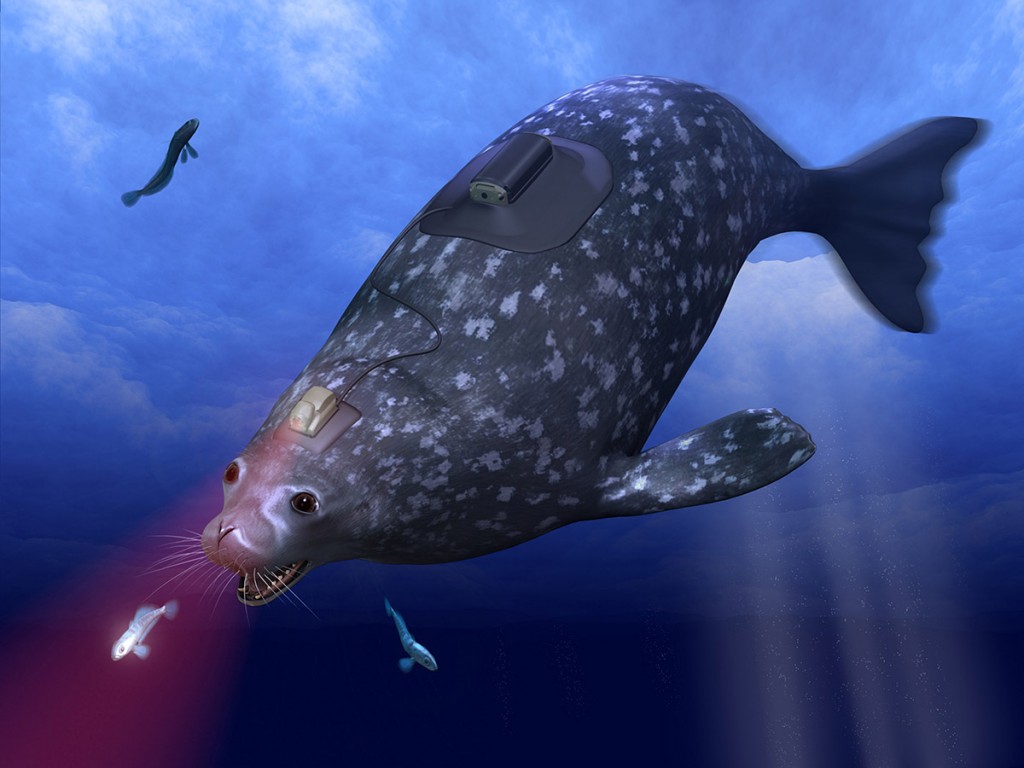How do seals return to their holes in the ice? New data may offer answers
Image: Texas A&M University
Some Weddell seals will soon be packing video and data recorders to help researchers led by a Texas A&M University at Galveston professor learn how these deep-diving creatures are able to return from long distances to their breathing holes in ice.
Randall Davis, a marine biologist who has studied the Weddell seal for 37 years, and colleagues Terrie Williams from the University of California-Santa Cruz and Lee Fuiman from the University of Texas, have a grant from the National Science Foundation to study the seals’ “magnetoreception,” a sensory system that allows an animal to detect the Earth’s geomagnetic field for orientation.
Weddell seals, native to Antarctica, can dive as deep as 2,600 feet below expansive, shore-fast ice in search of food, in any direction. But how they manage to return to their sparsely located breathing holes, most of them just a few feet in diameter, from over a mile away has always been something of a mystery.
“We noticed that these animals always found their way back, and they seemed to know exactly where the hole was located even during the Antarctic winter darkness,” Davis explains. “So what they are doing is very difficult as any human scuba diver without a compass has experienced. We didn’t understand how they managed to return every time.”
The team had previously observed the seals’ swimming patterns, which had characteristics similar to homing pigeons when setting their internal compass. This behavior enables them to return to their nests from long distances. The process, Davis says, is called “contouring behavior.”
“The behavior appears to be similar, except of course the seals are under the ice,” Davis adds. “We concluded that the seals are able to use the Earth’s geomagnetic field the same way we use a hand-held compass. Magnetoreception relies on the presence of magnetite, a crystal of iron oxide that is strongly magnetic, somewhere within the animal’s head.
“The Earth’s geomagnetic field leads to a neuronal signal via a physical effect on the magnetite which gives the animal a sense of direction,” he explains. “This sensory ability is absent in humans but appears to be present in many animals such a birds, sea turtles and perhaps some bats. We have suspected this sensory system in some marine mammals for a long time based on their long distance migrations. However, we need to validate it experimentally, and it turns out that Weddell seals swimming under Antarctic ice is a very good animal model.”
To do so, the team will work with seals that have been fitted with video and data recorders that will reveal their three-dimensional movements when placed in three isolated ice holes in McMurdo Sound. Each of the ice holes will be completely new to each seal and located in areas with a different geomagnetic orientation.
The team will then monitor the seals’ movements under the ice to determine whether they are using contouring to calibrate their internal compass just as homing pigeons do.
“We think that Weddell seals have very accurate magnetoreception because it is critical for them to find their way back to breathing holes in the ice,” Davis says.
“Although they have a remarkable breath-hold ability of up to 80 minutes, failure to find a breathing hole would result in drowning similar to a land mammal. Hence, the evolution of Weddell seals to exploit the expansive, shore-fast ice around Antarctica may have resulted in their impressive magnetoreception sensory system.
“Once we have data from 1,000 or more dives, we should we able to determine if their swimming patterns show statistically valid evidence of contouring behavior relative to the local geomagnetic field around each ice hole.” Davis notes.
“There is also the possibility that the seals are able to return to their breathing holes using their low-light sensitive vision to take advantage of under-ice features to relocate their ice hole. Alternatively, they might use their directional hearing to detect the vocalizations of other Weddell seals at an ice hole or crack in the ice. We will control for these other sensory systems by conducting some of the experiments during the Antarctic winter when light levels are very low and by using a directional hydrophone to map the vocalizations of other seals around the experimental ice holes.
“What we’re trying to do is to understand their entire range of navigational and under-ice orientation skills.”
Davis hopes that whey will have some definitive answers in the months to come, and the team hopes that it may reveal a little understood sensory system in other mammals that is difficult for humans to imagine.
The project is supported by the Office of Polar Programs at the National Science Foundation.
View footage of the seal cams.
#TAMUresearch
#12thManResearch


